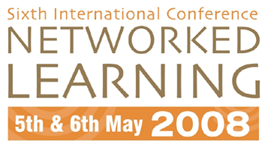

Teacher tools in a networked learning classroom: monitor, view and interpret interaction data
Eleni Voyiatzaki, Paris Polyzos, Nikolaos Avouris
Human-Computer Interaction Group, E&CE Dept., University of Patras,
Greece.
evoyiatz@ece.upatras.gr, ppolyzos@upnet.gr, avouris@upatras.gr
Abstract
During synchronous Computer Supported Collaborative Learning (CSCL) activities,
of multiple small groups working concurrently, a teacher is faced with
a strenuous, information rich situation, as students’ activities
produce multiple flows of data. These data, however, if used appropriately,
may help the supervisor interpret the situation and take effective regulatory
action. This requires a quick appraisal of the situation, based on a comparison
of the current situation to a model of a desired one, at various levels.
This is performed in the classroom by the teacher, taking into account
various experiences and knowledge of student’s personalities and
typical behaviours (Soller et al, 2005).
The design of a software tool that supports supervisors of CSCL classes
has been the objective of the research reported here. The tool has been
designed and tested in cases of real-time collaboration of small groups
(2-3 students) forming up a class (collocated or distant), interacting
during activities of limited duration (15 to 60 minutes), with the teacher
present physically or electronically. Students collaborate to solve a
problem, through Synergo, an environment with a shared drawing space through
which diagrammatic representations can be built jointly by a group and
a chatting tool for direct text based communication. To support teachers
in this context, we have designed a new tool, to assist their tasks in
collaborative classrooms. The tool, using the group activity logfiles,
builds various views implementing class, group and individuals’
interaction overviews and detailed views of the content of the process
A typical use of the supervisor tool is presented in the paper. In a typical
screenshot, parts of the screen refer to the class overview, related to
the collaboration activity, while other parts refer to the group and individuals’
process and problem solving views. The teacher can see at the class view
the groups and their members. Next group interactions may be monitored
using graphical representations, which change during groups’ activity.
Rules may be defined, which, if activated may cause certain actions or
draw the attention of the supervisor to certain events. The teacher can
focus in a group and view its dialogue, detect difficulties or misunderstandings,
or the current status of the solution specific group is working on. Current
solution instance can be represented in comparison with other groups’
solutions to detect differences that may lead to supervisor’s intervention
at group or class level. The supervisor may monitor individual's contribution,
either by content of messages or by comparing group members’ interactions.
The tool can be also used to reproduce the class activity, for off-line
class activity evaluation, or to simulate a class activity for training
purposes. All these use cases are currently evaluated during specific
studies. Further research is planned on the design of suitable alarms
to attract teacher’s attention, and support appropriate intervention.
| About NLC |
2008 Conference Papers
| Conference Committee| Keynote
Speakers
| Papers from previous NL conferences |Research Seminars| Current Conference
| Sponsors | Contact
|
